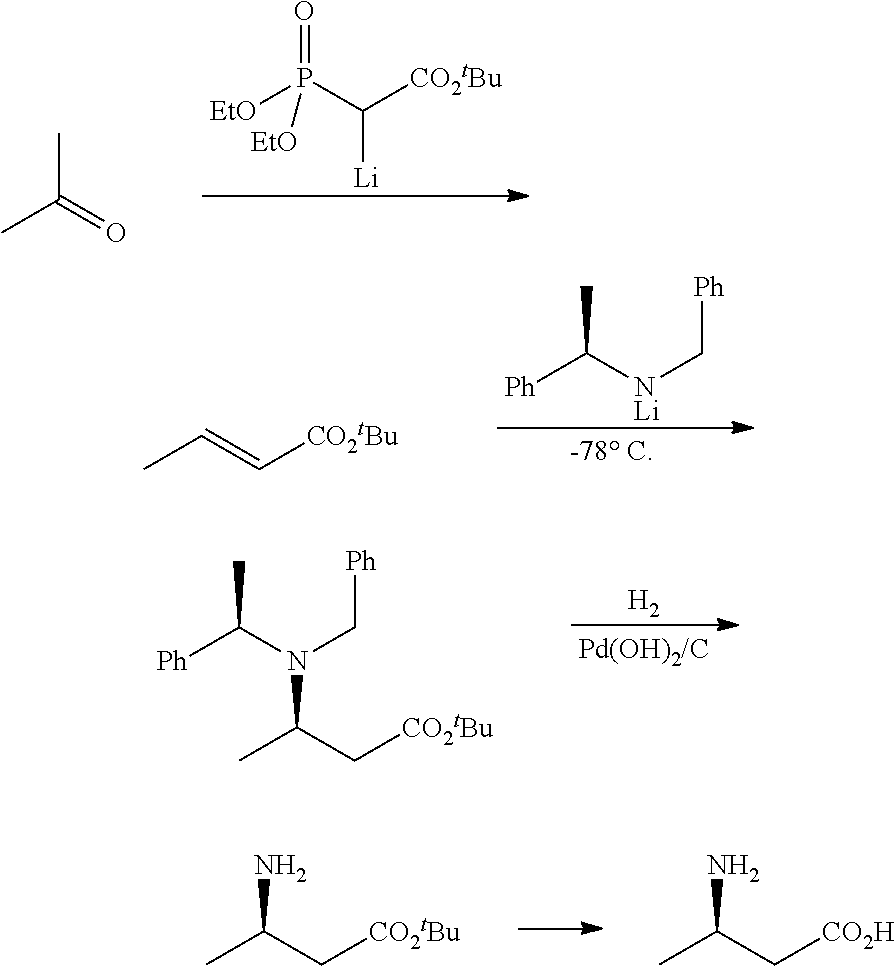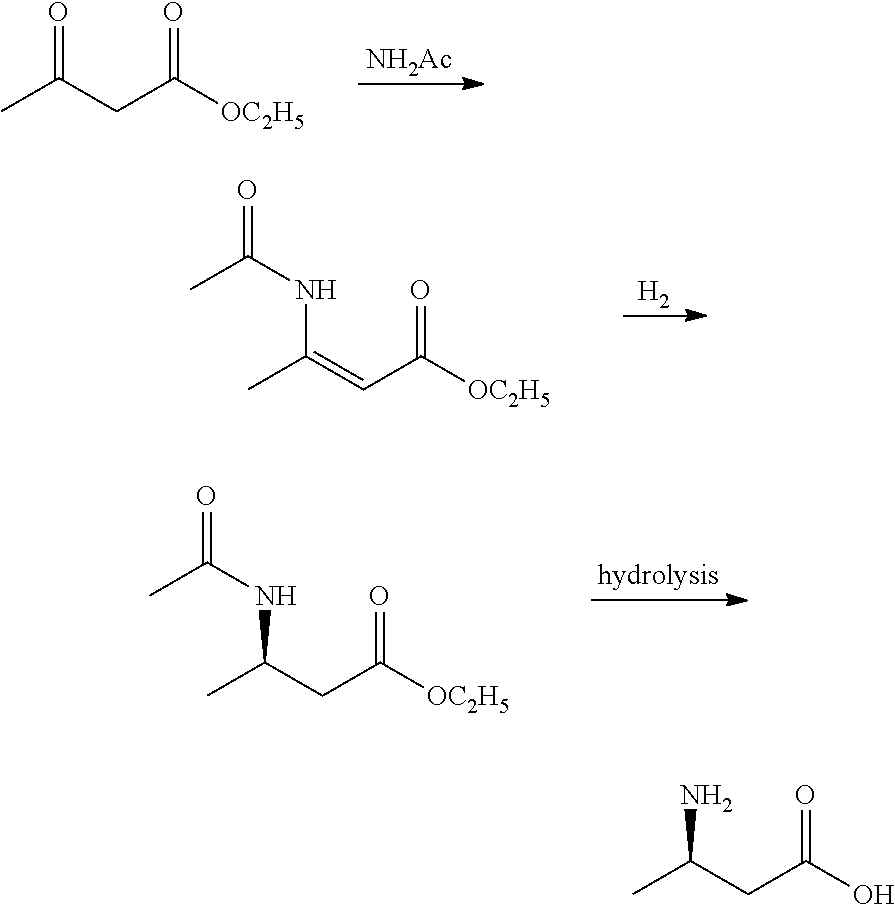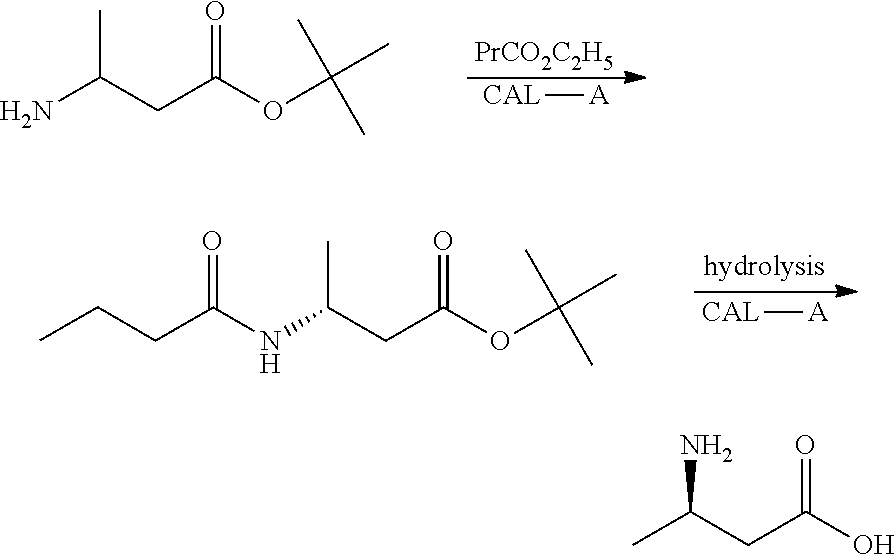Method for enzymatic preparation of r-3 aminobutyric acid
a technology of aminobutyric acid and enzymatic preparation, which is applied in the direction of lyases, carbon-nitrogen lyases, peptides, etc., can solve the problems of high production cost, heavy metal pollution, and difficult operation of the method, and achieve high stereoselectivity, improve conversion efficiency, and high efficiency
- Summary
- Abstract
- Description
- Claims
- Application Information
AI Technical Summary
Benefits of technology
Problems solved by technology
Method used
Image
Examples
example 1
Synthesis of R-3-aminobutyric Acid with AspA Wild-Type and the Detection Thereof
[0093]1.1 Preparation of AspA Wild Type Enzyme Solution
[0094]Based on the amino acid sequence of AspA wild-type (SEQ ID NO: 5), a DNA sequence (SEQ ID NO: 6) encoding the AspA wild-type enzyme was synthesized and linked to pET28a by enzymes, wherein the restriction enzyme cutting sites were NdeI and HindIII. The linked vector was transformed into the host E. coli BL21 competent cells. The strain was inoculated in the TB medium, and cultured in a shaker at 37° C., 200 rpm until the OD600 value reached 4.0. Then IPTG having a concentration of 0.1 mM was added for induction, the temperature was adjustd to 28° C. and the culture was continued for 12 hours. The bacterial cells were collectd by centrifugation at 4° C., and resuspended with phosphate buffer (50 mM, pH 7.0). The cells were homogenized and disrupted to obtain AspA wild-type enzyme solution.
[0095]Amino acid sequence of AspA wild type:
(SEQ ID NO: 5...
example 2
Synthesis of R-3-aminobutyric Acid with AspA Mutant 1 and the Detection Thereof
[0101]2.1 Preparation of AspA Mutant 1 Enzyme Solution
[0102]All of the amino acids at the 4 mutation sites of AspA mutant 1 were mutated (see Tables 1 and 2). Based on the amino acid sequence of AspA mutant 1 (SEQ ID NO: 3), a DNA sequence (SEQ ID NO: 4) encoding the AspA mutant 1 enzyme was synthesized and linked to pET28a by enzymes, wherein the restriction enzyme cutting sites were NdeI and HindIII. The linked vector was transformed into the host E. coli BL21 competent cells. The strain was inoculated in the TB medium, and cultured in a shaker at 37° C., 200 rpm until the OD600 value reached 4.0. Then IPTG having a concentration of 0.1 mM was added for induction, the temperature was adjustd to 28° C. and the culture was continued for 12 hours. The bacterial cells were collectd by centrifugation at 4° C., and resuspended with phosphate buffer (50 mM, pH 7.0). The cells were homogenized and disrupted to ...
example 3
Synthesis of R-3-aminobutyric Acid with AspA Mutants 2-12 and the Detection Thereof
[0110]3.1 Preparation of AspA Mutants 2-12 Enzyme Solutions
[0111]The specific mutations of AspA mutants 2-12 are shown in Tables 1 and 2. AspA mutants 2-5 are single amino acid mutation, AspA mutants 6-8 have amino acid mutations at two mutation sites, and AspA mutants 9-12 have amino acid mutations at three mutation sites.
[0112]Based on the amino acid sequences of AspA mutants 2-12, DNA sequences encoding the enzymes of each AspA mutant were synthesized respectively. The preparation method of the enzyme solution was the same as in Example 2.1.
TABLE 1Positions and changes of mutant amino acidspositionWild typeMutantMutation site 1 (amino acidThreonine (T)Cysteine (C)at position 204)Mutation site 2 (amino acidMethionine (M)Isoleucine (I)at position 338)Mutation site 3 (amino acidLysine (K)Methionine (M)at position 341)Mutation site 4 (amino acidAsparagine (N)Cysteine (C)at position 343)
TABLE 2Conversio...
PUM
| Property | Measurement | Unit |
|---|---|---|
| Fraction | aaaaa | aaaaa |
| Acidity | aaaaa | aaaaa |
| Catalytic activity | aaaaa | aaaaa |
Abstract
Description
Claims
Application Information
 Login to View More
Login to View More - R&D
- Intellectual Property
- Life Sciences
- Materials
- Tech Scout
- Unparalleled Data Quality
- Higher Quality Content
- 60% Fewer Hallucinations
Browse by: Latest US Patents, China's latest patents, Technical Efficacy Thesaurus, Application Domain, Technology Topic, Popular Technical Reports.
© 2025 PatSnap. All rights reserved.Legal|Privacy policy|Modern Slavery Act Transparency Statement|Sitemap|About US| Contact US: help@patsnap.com



